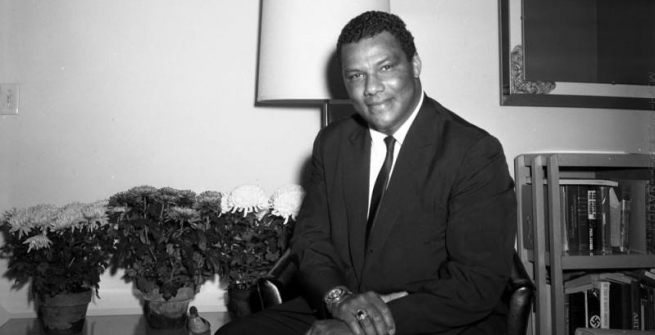Rolland J. Curtis needs your help—well, ok. Maybe photographer Rolland J. Curtis does not need your help, but the library certainly does!
Let me set the scene for you:
Have you ever looked at a digitized historical photograph and exclaimed, 'Hey! I know that man!', only to look for his name and not have it listed on the description? Or looked at a photograph of several women attending an event, only to notice your Auntie Jean is pictured but not identified? If you answered no, then you are in the majority. But if you answered yes, then Rolland Curtis...and the library...needs your help!
And this is where your help may be of utmost value to us here at the Los Angeles Public Library, and especially to us in the Digitization and Special Collections and Photo departments, but yet more specifically, to us photo catalogers, who could use all of the help we can get with a particular collection in our holdings. What collection, you ask? The Rolland J. Curtis collection.
So, who is Rolland J. Curtis?
Rolland Joseph 'Speedy' Curtis was born in Louisiana in 1922. After serving three years in the Marines during World War II, he and his wife, Gloria, relocated from New Orleans to Los Angeles in 1946. Curtis served four years with the Los Angeles Police Department, but resigned from the force in order to pursue both a Bachelor's and Master's degree from the University of Southern California, where he also played football and obtained the nickname “Speedy.” He later became involved in city politics, as an associate of Sam Yorty, and later a field deputy to City Council members Billy G. Mills and Tom Bradley, who were two of the first African-American men to be elected to the Los Angeles City Council, with Bradley later becoming the first black mayor of Los Angeles. In 1973 Curtis was appointed director of the Model Cities program, a comprehensive five-year plan to address the social, economic, and physical problems of poor and underserved neighborhoods using public and private resources. He resigned from the Model Cities program in 1974 and opened a publicity shop. He later began working for Billy Mills again, remaining on the councilman’s staff until Governor Ronald Reagan appointed Mills to the California Superior Court. Curtis ran for Mills’ vacant council seat but was defeated. He ran a second time, in 1978, but was defeated again. Tragically, Curtis died in his home on Mother’s Day in 1979, the victim of homicide during a burglary. An affordable housing complex on Exposition Blvd. near Vermont Ave. was named in his honor in 1981, along with a nearby street and park.
While serving as Field Deputy, Curtis took photographs that documented African-American life in Los Angeles during the 1960s and 70s, particularly in the political realm. These photographs are now part of the Los Angeles Public Library's Rolland J. Curtis Collection of Negatives and Photographs.
And this is where you come in. This is where your help can be invaluable to us and the Rolland J. Curtis Collection:
- Did you have any family or friends with political ties in the 1960s and 70s?
- Did you have any family or friends that were prominent, or possibly attended prominent events in the 1960s and 70s?
- Do you know if your parents, older family members, older friends, or maybe even older neighbors held events whose stories may have been featured in the newspaper in the 1960s and 70s?
We would love it if you could browse our Rolland J. Curtis Collection and take a look at the photographs. Only a very small handful of these photos include Rolland, his wife Gloria, or even his mother, Mathilda. But, all of the photos were taken by Curtis, himself. However, not all of them have information identifying people pictured. And, wouldn't it be great if we could give those faces proper identification?
To view the photographs in the collection with unidentified individuals, follow this link. If there is anyone you recognize, write down the Order Number (toward the top left of the description section), and the name of the person you recognize (with any other identifiable description if there are several people pictured). Send your information to rarebook@lapl.org and once confirmed, we will adjust our descriptions to include names of those pictured.
I know Rolland would appreciate your help, and I know the library would as well.
So thank you in advance, and we look forward to cataloging many, many, more Rolland J. Curtis photographs in the very near future—to the tune of at least 12,000!
